High Flying Electronics Technology HF-LPB125 HF-LPB125 User Manual
High-Flying Electronics Technology Co., Ltd. HF-LPB125 Users Manual
User Manual

HF-LPB125 Low Power Wi-Fi Module User Manual
Shanghai High-Flying Electronics Technology Co., Ltd(www.hi-flying.com) -1-
HF-LPB125
Low Power Wi-Fi Module User Manual
V1.0
Overview of Characteristic
Support IEEE802.11b/g/n Wireless Standards
Based on Self-developed High Cost SOC
Ultra-Low-Power for Battery Applications with Excellent Power Save Scheme
Support UART/GPIO Data Communication Interface
Support Work As STA/APMode
Support Smart Link Function (APP program provide)
Support Wireless and Remote Firmware Upgrade Function
Support Internal Antenna Option
Single +5V Power Supply, +5V UART Voltage.
Smallest Size: 41.3mm x 24.1mm x 6mm, 2x4 Pin 2.54mm pin header or 4 Pin 2.5mm
Header
FCC/CE Certificated

HF-LPB125 Low Power Wi-Fi Module User Manual
Shanghai High-Flying Electronics Technology Co., Ltd(www.hi-flying.com) -2-
TABLE OF CONTENTS
LIST OF FIGURES.................................................................................................................................................3
LIST OF TABLES.................................................................................................................................................. 4
HISTORY................................................................................................................................................................. 5
1. PRODUCT OVERVIEW............................................................................................................................ 6
1.1. General Description.............................................................................................................................6
1.1.1 Device Features..............................................................................................................................6
1.1.2 Device Paremeters.........................................................................................................................7
1.1.3 Key Application...............................................................................................................................7
1.2. Hardware Introduction........................................................................................................................ 8
1.2.1. Pins Definition................................................................................................................................. 8
1.2.2. Electrical Characteristics............................................................................................................... 9
1.2.3. Mechanical Size........................................................................................................................... 10
1.2.4. Order Information......................................................................................................................... 11
1.3. Typical Application............................................................................................................................11
2. PACKAGE INFORMATION.................................................................................................................. 12
2.1. Recommended Reflow Profile........................................................................................................ 12
2.2. Device Handling Instruction (Module IC SMT Preparation)....................................................12
2.3. Shipping Information(TBD)............................................................................................................. 13
APPENDIX E: CONTACT INFORMATION............................................................................................... 16

HF-LPB125 Low Power Wi-Fi Module User Manual
Shanghai High-Flying Electronics Technology Co., Ltd(www.hi-flying.com) -3-
LIST OF FIGURES
Figure 1. HF-LPB125 Pins Map........................................................................................................................ 8
Figure 2. HF-LPB125 Mechanical Dimension.............................................................................................. 10
Figure 3. HF-LPB125 Order Information....................................................................................................... 11
Figure 4. Reflow Soldering Profile..................................................................................................................12
Figure 5. Shipping Information........................................................................................................................13

HF-LPB125 Low Power Wi-Fi Module User Manual
Shanghai High-Flying Electronics Technology Co., Ltd(www.hi-flying.com) -4-
LIST OF TABLES
Table 1 HF-LPB125 Module Technical Specifications.................................................................................7
Table 2 HF-LPB125 Pins Definition................................................................................................................ 8
Table 11 Reflow Soldering Parameter............................................................................................................12

HF-LPB125 Low Power Wi-Fi Module User Manual
Shanghai High-Flying Electronics Technology Co., Ltd(www.hi-flying.com) -5-
HISTORY
Ed. V1.0 03-02-2016 First Version.

HF-LPB125 Low Power Wi-Fi Module User Manual
Shanghai High-Flying Electronics Technology Co., Ltd(www.hi-flying.com) -6-
1. PRODUCT OVERVIEW
1.1. General Description
The HF-LPB125 is a fully self-contained small form-factor, single stream, 802.11b/g/n Wi-Fi module,
which provide a wireless interface to any equipment with a Serial/SPI interface for data transfer.HF-
LPB125 integrate MAC, baseband processor, RF transceiver with power amplifier in hardware and all
Wi-Fi protocol and configuration functionality and networking stack, in embedded firmware to make a
fully self-contained 802.11b/g/n Wi-Fi solution for a variety of applications.
The HF-LPB125 employs the world's lowest power consumption embedded architecture. It has been
optimized for all kinds of client applications in the home automation, smart grid, handheld device,
personal medical application and industrial control that have lower data rates, and transmit or receive
data on an infrequent basis.
The HF-LPB125 integrates all Wi-Fi functionality into a low-profile, 41.3mm x 24.1mm x 6mm SMT
module package that can be easily mounted on main PCB with application specific circuits. Also,
module provides built-in antenna option.
1.1.1 Device Features
Single stream Wi-Fi @ 2.4 GHz with support for WEP security mode as well as WPA/WPA2
Based on Self-developed High Cost Performance MCU
Ultra-low-power operation with all kinds of power-save modes.
Includes all the protocol and configuration functions for Wi-Fi connectivity.
Support STA/AP Mode
Support Smart Link Function
Support Wireless and Remote Firmware Upgrade Function
Integrated PCB antenna or I-PEX antenna connector options.
Compact surface mount module 41.3mm x 24.1mm x 6mm.
Full IPv4 stack.
Low power RTOS and drivers.
CE/FCC Certified.
RoHS compliant.
Single supply – 5V operation.
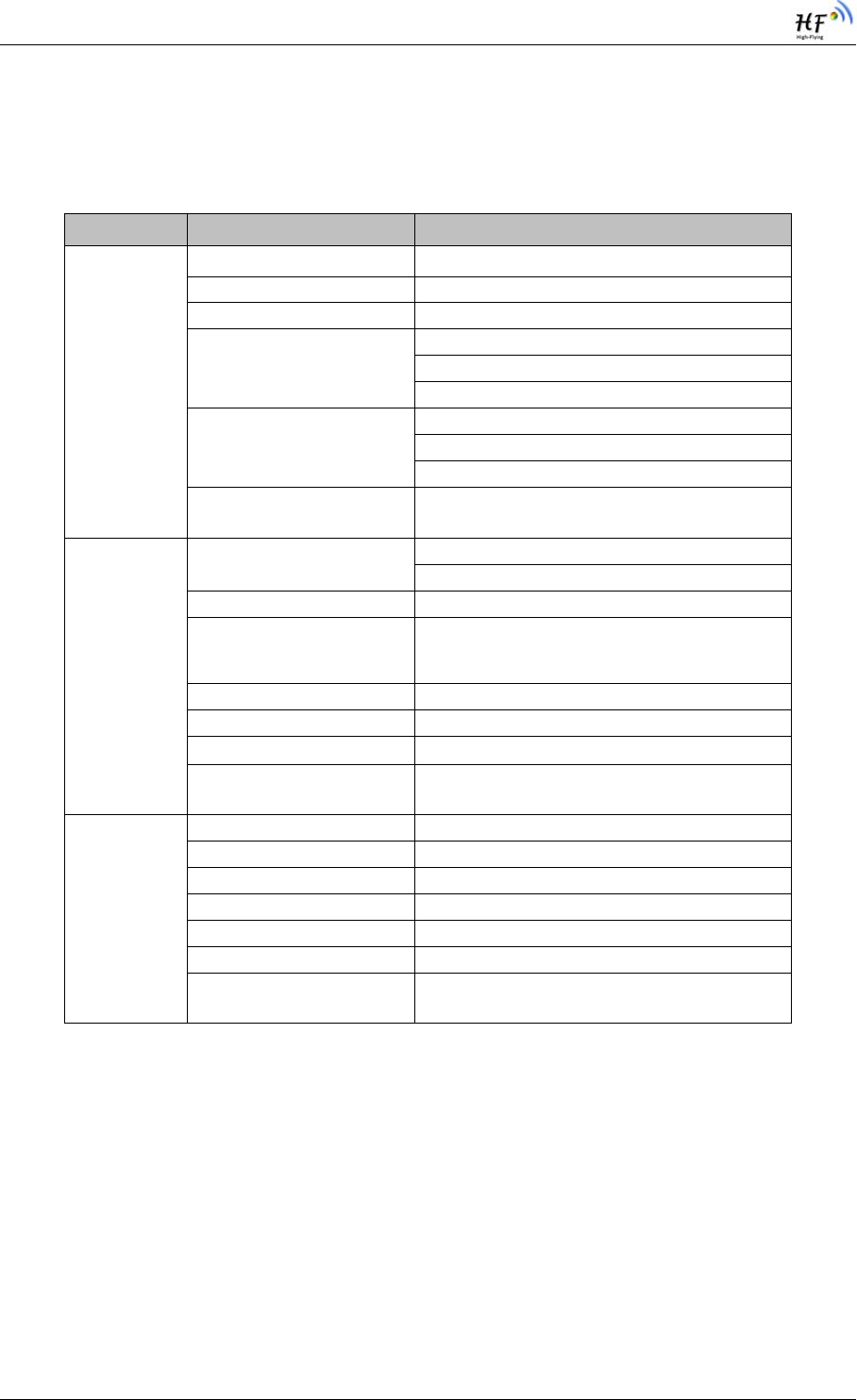
HF-LPB125 Low Power Wi-Fi Module User Manual
Shanghai High-Flying Electronics Technology Co., Ltd(www.hi-flying.com) -7-
1.1.2 Device Paremeters
Table 1 HF-LPB125 Module Technical Specifications
Class Item Parameters
Wireless
Parameters
Certification FCC/CE
Wireless standard 802.11 b/g/n
Frequency range 2.412GHz-2.462GHz
Transmit Power
802.11b: +16 +/-2dBm (@11Mbps)
802.11g: +14 +/-2dBm (@54Mbps)
802.11n: +13 +/-2dBm (@HT20, MCS7)
Receiver Sensitivity
802.11b: -93 dBm (@11Mbps ,CCK)
802.11g: -85 dBm (@54Mbps, OFDM)
802.11n: -82 dBm (@HT20, MCS7)
Antenna Option Internal:On-board PCB antenna
Hardware
Parameters
Data Interface UART
GPIO
Operating Voltage 4.75~6V
Operating Current
Peak [Continuous TX]: ~300mA
Normal [WiFi ON/OFF, DTIM=100ms]:
Average. ~12mA, Peak: 300mA
Operating Temp. -20℃-85℃
Storage Temp. -40℃- 125℃
Dimensions and Size 41.3mm x 24.1mm x 6mm
External Interface 2x4 pin 2.54mm PIN or 4pin 2.5mm
header
Software
Parameters
Network Type STA /AP
Security Mechanisms WEP/WPA-PSK/WPA2-PSK
Encryption WEP64/WEP128/TKIP/AES
Update Firmware Local Wireless, Remote
Customization Support SDK for application develop
Network Protocol IPv4, TCP/UDP/HTTP
User Configuration AT+instruction set. Android/ iOS
Smart Link APP tools
1.1.3 KeyApplication
Remote equipment monitoring
Asset tracking and telemetry
Security
Industrial sensors and controls
Home automation
Medical devices
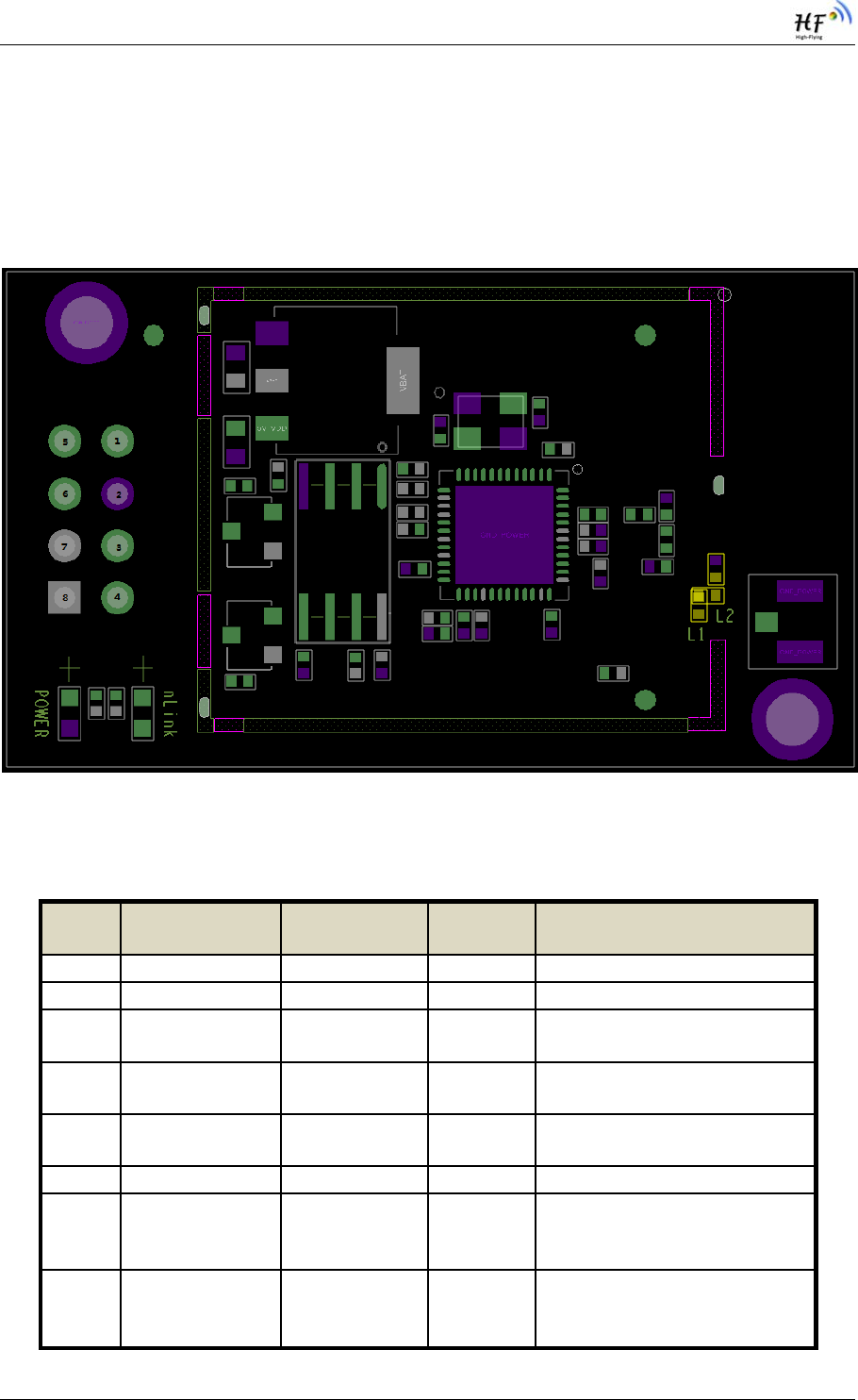
HF-LPB125 Low Power Wi-Fi Module User Manual
Shanghai High-Flying Electronics Technology Co., Ltd(www.hi-flying.com) -8-
1.2. Hardware Introduction
1.2.1. Pins Definition
Figure 1. HF-LPB125 Pins Map
Table 2 HF-LPB125 Pins Definition
Pin Describtion Net Name Signal
Type
Comments
1 +5V Power DVDD Power 5V@250m
A
2Gr
ound GNDPower
3 UART0 UART0_RX I,PU 5V, GPIO19. No connect if not
use.
4 UART0 UART0_TX O,PU 5V, GPIO20. No connect if not
use.
5 Multi-Function nReload I,PU 3.3V, GPIO2. Detailed
functions see <Notes>
6 Module Reset EXT_RESETn I,PU 3.3V, “Low” effective reset input.
7 GPIO GPIO5 I/O 3.3V I/O, UART1_TXD debug
output
No connect if not use.
8 GPIO GPIO6 I/O 3.3V I/O, UART1_RXD debug
input
No connect if not use.
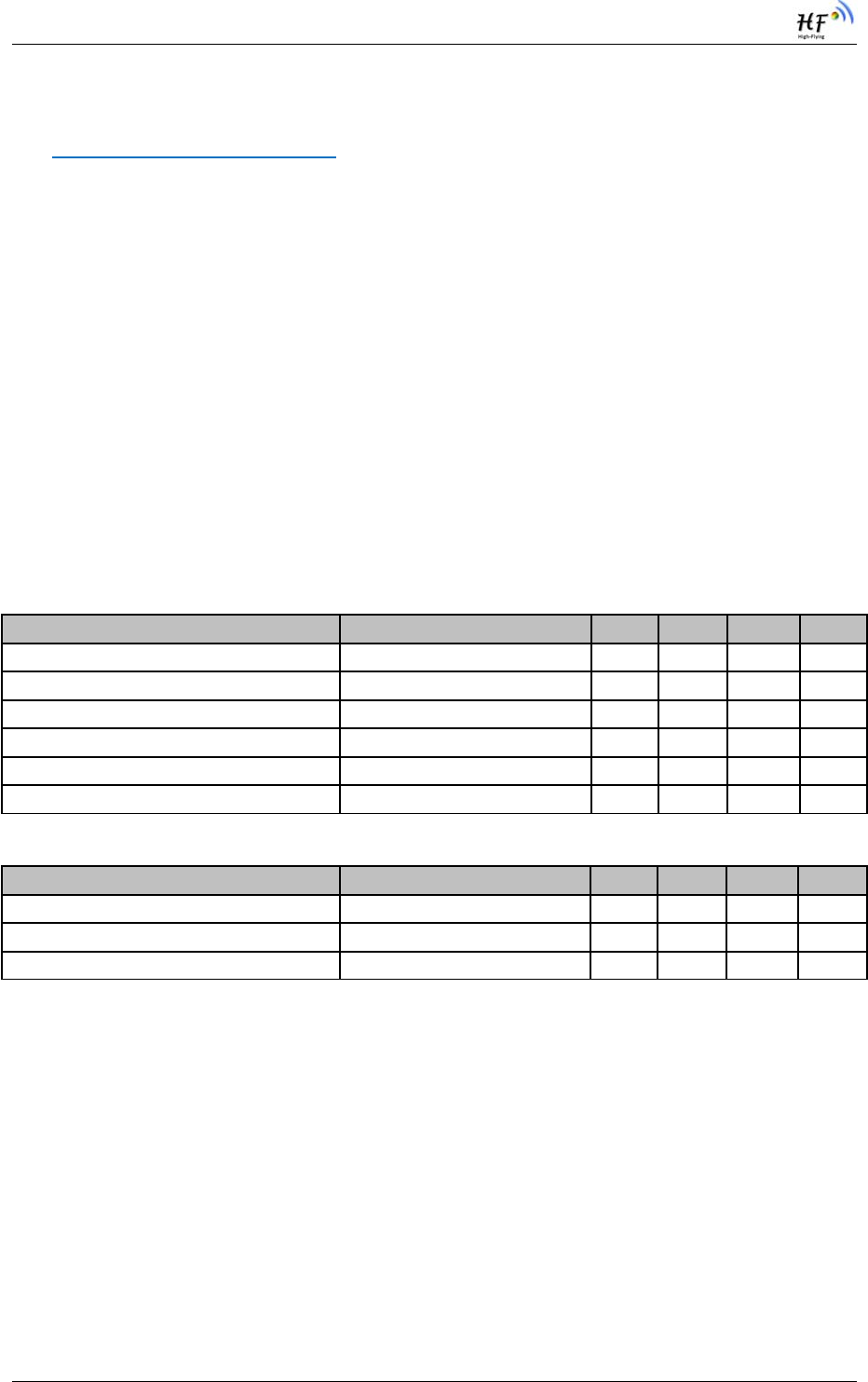
HF-LPB125 Low Power Wi-Fi Module User Manual
Shanghai High-Flying Electronics Technology Co., Ltd(www.hi-flying.com) -9-
<Notes>
Module Pin4 must be high when bootup.
nReload Pin (Button) function:
1. When this pin is set to “low” during module boot up, the module will enter wireless
firmware and config upgrade mode. This mode is used for customer manufacture.
(See Appendix D to download software tools for customer batch configuration and
upgrade firmware during mass production)
2. After module is powered up, short press this button ( “Low” < = 2s ) to make the
module go into “Smart Link “ config mode, waiting for APP to set password and
other information. (See Appendix D to download SmartLink APP)
3. After module is powered up, long press this button ( “Low” >= 4s ) to make the
module recover to factory setting.
High-Flying strongly suggest customer fan out this pin to connector or button for
“Manufacture” and “ Smart Link” application.
1.2.2. Electrical Characteristics
Absolute Maximum Ratings:
Parameter Condition Min. Typ.Max. Unit
Storage temperature range -40 125 °C
Maximum soldering temperature IPC/JEDEC J-STD-020 260 °C
Supply voltage 4.75 6 V
Voltage on any I/O pin 0 5/3.3 V
ESD (Human Body Model HBM) TAMB=25°C 2.5 KV
ESD (MM) TAMB=25°C 0.25 KV
Power Supply & Power Consumption:
Parameter Condition Min. Typ.Max. Unit
Operating Supply voltage 4.75 5 6 V
Supply current, peak Continuous Tx 280 mA
Supply current, IEEE PS DTIM=100ms 20 mA
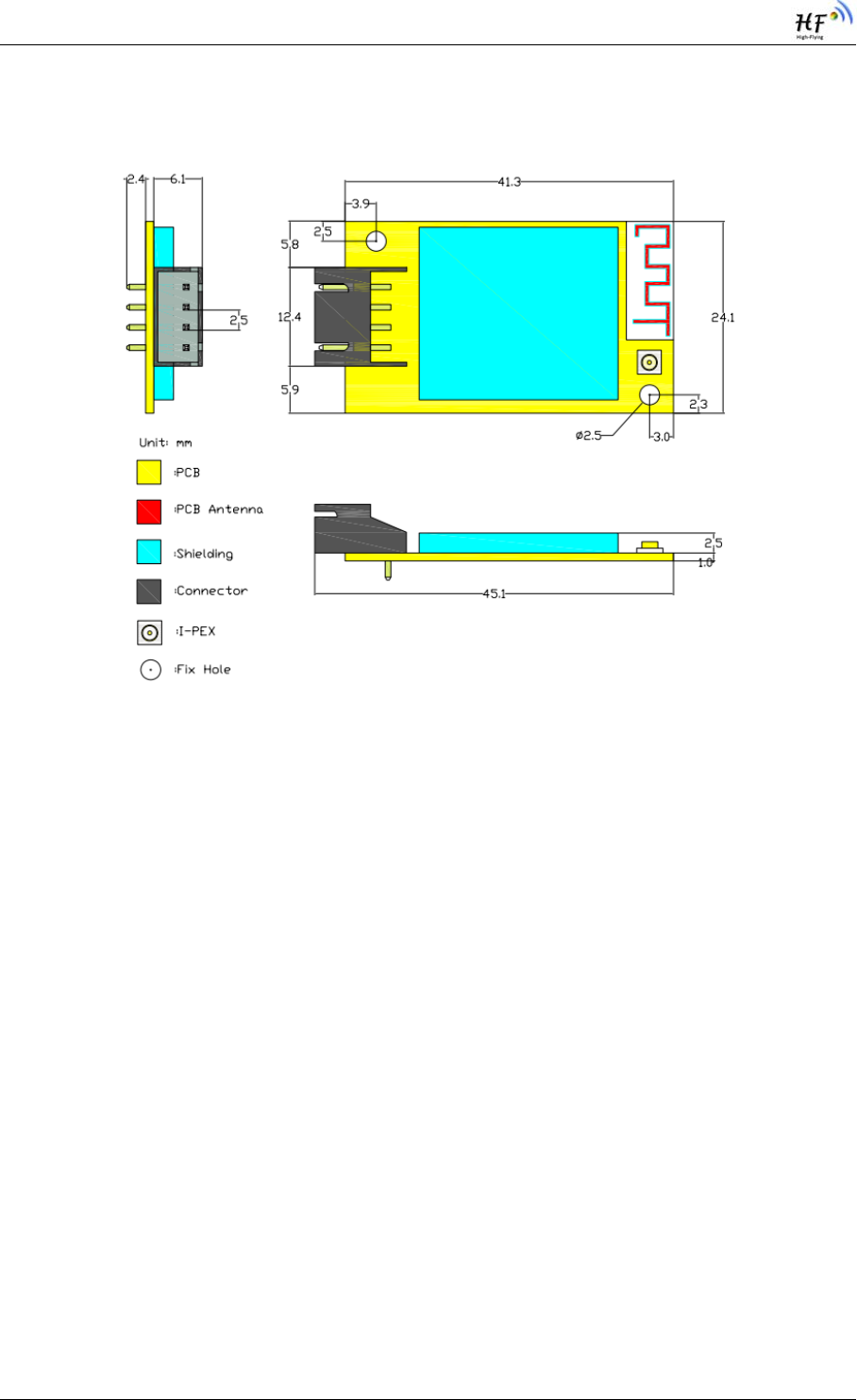
HF-LPB125 Low Power Wi-Fi Module User Manual
Shanghai High-Flying Electronics Technology Co., Ltd(www.hi-flying.com) -10 -
1.2.3.Mechanical Size
HF-LPB125 modules physical size (Unit: mm)as follows:
Figure 2. HF-LPB125 Mechanical Dimension
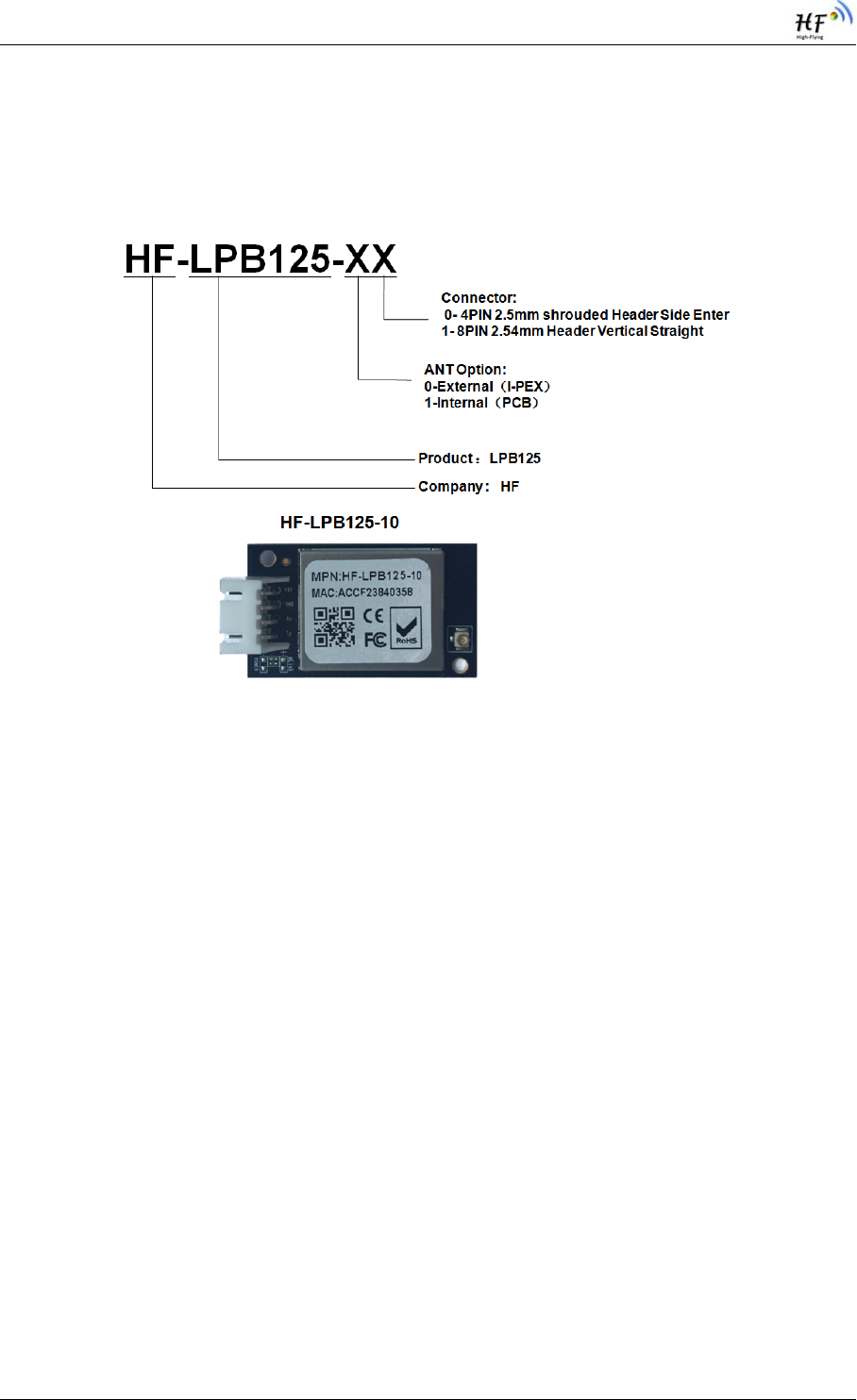
HF-LPB125 Low Power Wi-Fi Module User Manual
Shanghai High-Flying Electronics Technology Co., Ltd(www.hi-flying.com) -11 -
1.2.4.Order Information
Base on customer detailed requirement, HF-LPB125 series modules provide different variants and
physical type for detailed application.
Figure 3. HF-LPB125 Order Information
1.3. Typical Application
Refer to HF-LPB120 user manual for detailed application and module usage.
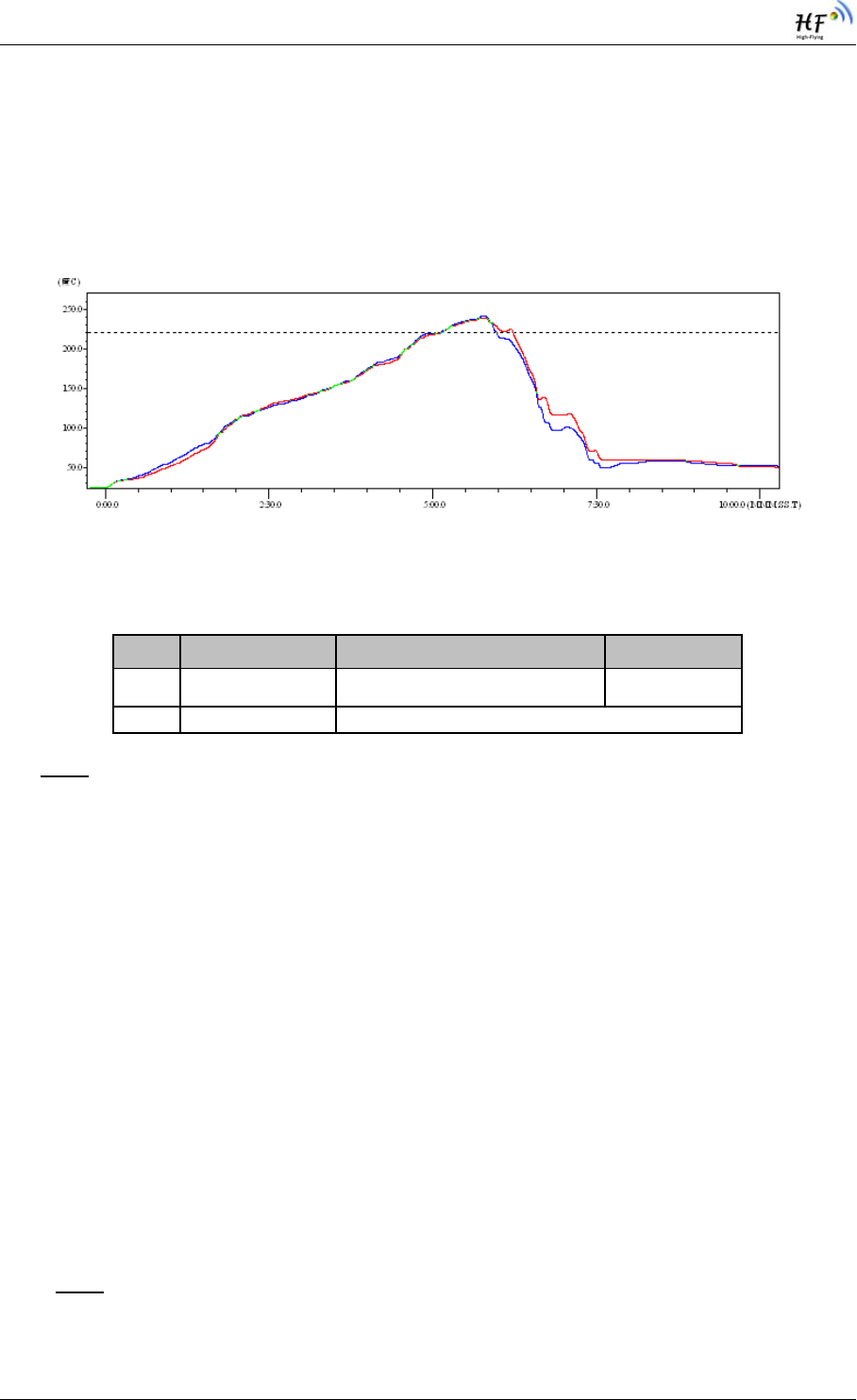
HF-LPB125 Low Power Wi-Fi Module User Manual
Shanghai High-Flying Electronics Technology Co., Ltd(www.hi-flying.com) -12 -
2. PACKAGE INFORMATION
2.1. Recommended Reflow Profile
Figure 4. Reflow Soldering Profile
Table 11 Reflow Soldering Parameter
Note: 1. Recommend to supply N2 for reflow oven.
2. N2 atmosphere during reflow (O2<300ppm)
2.2. Device Handling Instruction (Module IC SMT Preparation)
1. Shelf life in sealed bag: 12 months, at <30℃and <60% relative humidity (RH)
2. After bag is opened, devices that will be re-baked required after last baked with window time
168 hours.
3. Recommend to oven bake with N2 supplied
4. Recommend end to reflow oven with N2 supplied
5. Baked required with 24 hours at 125+-5℃before rework process for two modules, one is
new module and two is board with module
6. Recommend to store at ≦10% RH with vacuum packing
7. If SMT process needs twice reflow:
(1) Top side SMT and reflow (2) Bottom side SMT and reflow
Case 1: Wifi module mounted on top side. Need to bake when bottom side processover168
hours window time, no need to bake within 168 hours
Case 2: Wifi module mounted on bottom side, follow normal bake rule before process
Note: Window time means from last bake end to next reflow start that has 168 hours space.
NO. Item Temperature (Degree) Time(Sec)
1 Reflow Time Time of above 220 35~55 sec
2 Peak-Temp 260 max
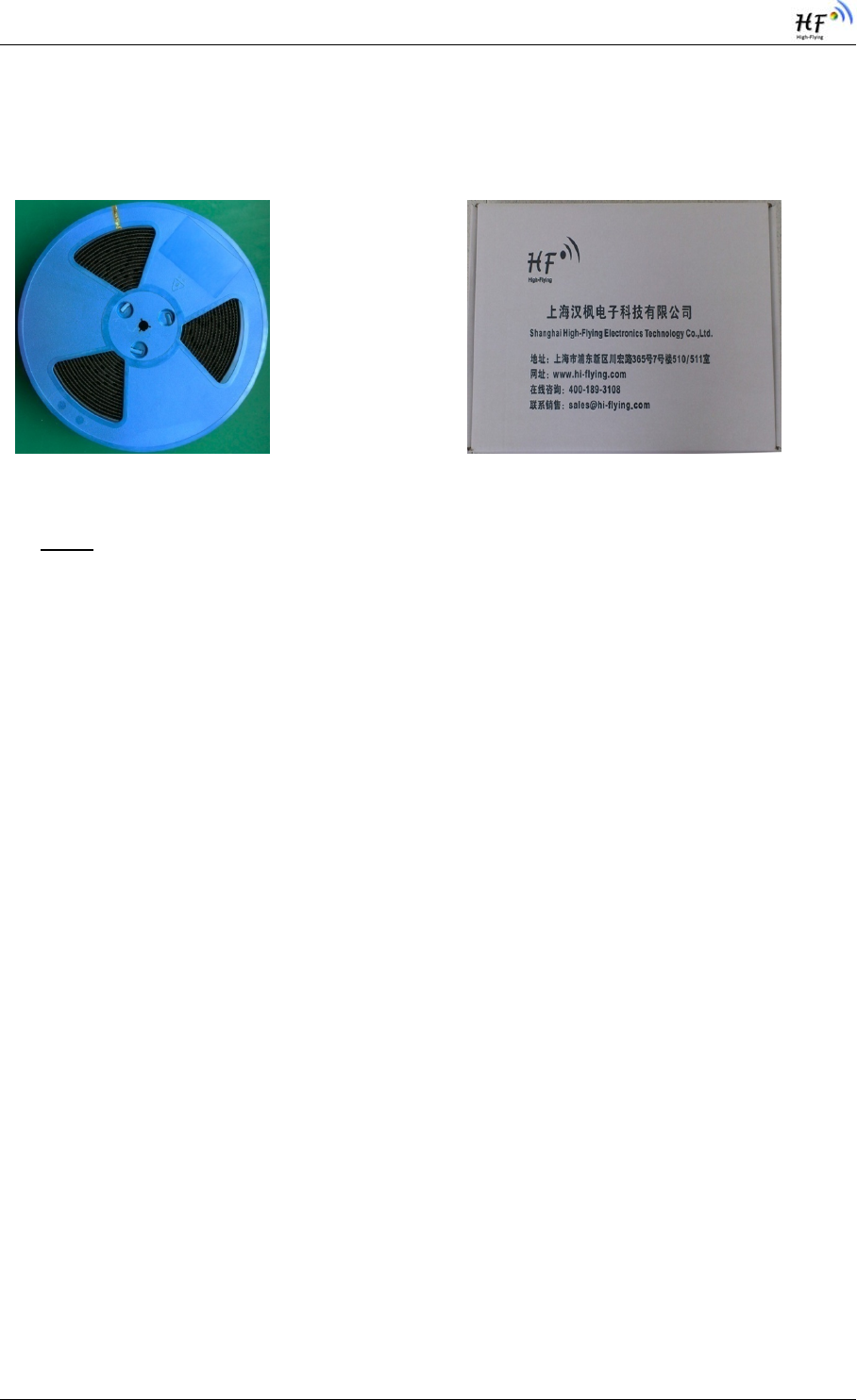
HF-LPB125 Low Power Wi-Fi Module User Manual
Shanghai High-Flying Electronics Technology Co., Ltd(www.hi-flying.com) -13 -
2.3. Shipping Information(TBD)
TAPE BOX
Size: 340*340*70 mm Size: 340*340*350 mm (inside)
Figure 5. Shipping Information
Note:
1tape=500pcs
1 box = 5 tapes = 5 * 500 pcs = 2500pcs
FCC STATEMENT:
This device complies with Part 15 of the FCC Rules. Operation is subject to the following two
conditions:
(1) This device may not cause harmful interference, and
(2) This device must accept any interference received, including interference that may cause
undesired operation.
Warning: Changes or modifications not expressly approved by the party responsible for compliance
could void the user's authority to operate the equipment.
NOTE: This equipment has been tested and found to comply with the limits for a Class B digital device,
pursuant to Part 15 of the FCC Rules. These limits are designed to provide reasonable protection
against harmful interference in a residential installation.
This equipment generates uses and can radiate radio frequency energy and, if not installed and used
in accordance with the instructions, may cause harmful interference to radio communications.
However, there is no guarantee that interference will not occur in a particular installation. If this
equipment does cause harmful interference to radio or television reception, which can be determined

HF-LPB125 Low Power Wi-Fi Module User Manual
Shanghai High-Flying Electronics Technology Co., Ltd(www.hi-flying.com) -14 -
by turning the equipment off and on, the user is encouraged to try to correct the interference by one or
more of the following measures:
Reorient or relocate the receiving antenna.
Increase the separation between the equipment and receiver.
Connect the equipment into an outlet on a circuit different from that to which the receiver is connected.
Consult the dealer or an experienced radio/TV technician for help.
FCC Radiation Exposure Statement:
This equipment complies with FCC radiation exposure limits set forth for an uncontrolled environment.
This equipment should be installed and operated with minimum distance 20cm between the radiator &
your body.
FCC INFORMATION (additional)
OEM INTEGRATION INSTRUCTIONS:
This device is intended only for OEM integrators under the following conditions: The module must
be installed in the host equipment such that 20 cm is maintained between the antenna and users,
and the transmitter module may not be co-located with any other transmitter or antenna. The
module shall be only used with the internal antenna(s) that has been originally tested and
certified with this module. As long as 3 conditions above are met, further transmitter test will not
be required. However, the OEM integrator is still responsible for testing their end-product for any
additional compliance requirements required with this module installed (for example, digital
device emissions, PC peripheral requirements, etc.).
Validity of using the module certification:
In the event that these conditions cannot be met (for example certain laptop configurations or co-
location with another transmitter), then the FCC authorization for this module in combination with
the host equipment is no longer considered valid and the FCC ID of the module cannot be used
on the final product. In these circumstances, the OEM integrator will be responsible for re-
evaluating the end product (including the transmitter) and obtaining a separate FCC authorization.

HF-LPB125 Low Power Wi-Fi Module User Manual
Shanghai High-Flying Electronics Technology Co., Ltd(www.hi-flying.com) -15 -
End product labeling:
Information that must be placed in the end user manual:
The OEM integrator has to be aware not to provide information to the end user regarding how to
install or remove this RF module in the user's manual of the end product which integrates this
module. The end user manual shall include all required regulatory information/warning as show in
this manual.
Antenna Specification:
Type: PCB Antenna
Model: HF-LPB125
Brand: High-Flying
Gain: 3dBi
The final end product must be labeled in a visible area with the following: “Contains FCC ID:
2ACSVHF-LPB125”.
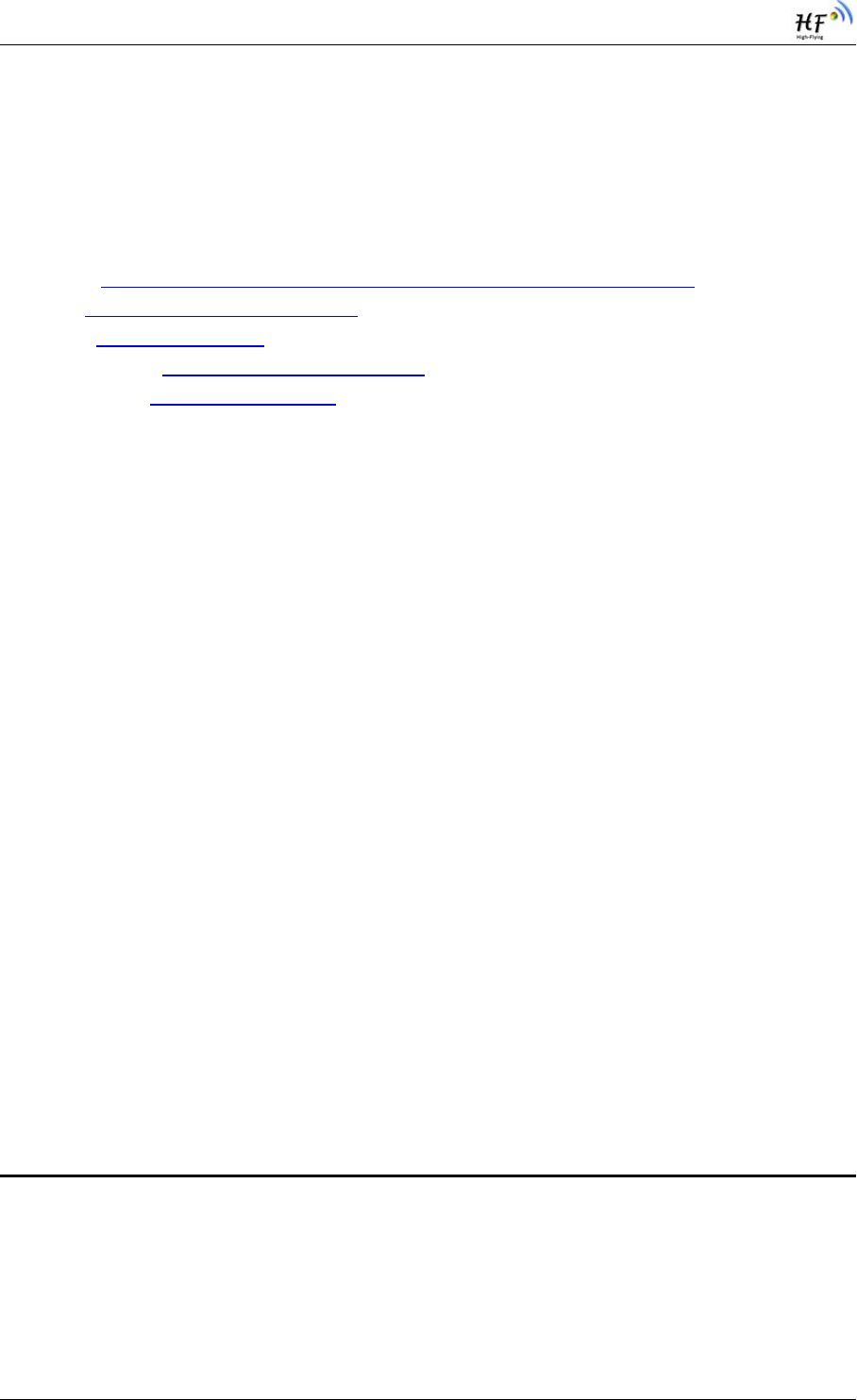
HF-LPB125 Low Power Wi-Fi Module User Manual
Shanghai High-Flying Electronics Technology Co., Ltd(www.hi-flying.com) -16 -
APPENDIX E: CONTACT INFORMATION
------------------------------------------------------------------------------------------------------------
Address: Room 1002,Building 1,No.3000,Longdong Avenue,Pudong New
Area,Shanghai,China,201203
Web: www.hi-flying.com
Service Online: 400-189-3108/18616078755
Sales Contact: sales@hi-flying.com
-----------------------------------------------------------------------------------------------------------
For more information about High-Flying modules, applications, and solutions, please visit our web site
http://www.hi-flying.com/en/
<END OF DOCUMENT>
© Copyright High-Flying, May, 2011
The information disclosed herein is proprietary to High-Flying and is not to be used by or disclosed to
unauthorized persons without the written consent of High-Flying. The recipient of this document shall respect the
security status of the information.
The master of this document is stored on an electronic database and is “write-protected” and may be altered only
by authorized persons at High-Flying. Viewing of the master document electronically on electronic database
ensures access to the current issue. Any other copies must be regarded as uncontrolled copies.